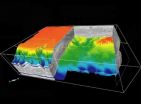(Press-News.org) CORVALLIS, Ore. – A new study concludes that models may be predicting releases of atmospheric carbon dioxide that are either too high or too low, depending on the region, because they don't adequately reflect variable temperatures that can affect the amount of carbon released from soil.
The study points out that many global models make estimates of greenhouse gas emissions from soils based on "average" projected temperatures. But temperatures vary widely from those averages. That variability, along with complex biological processes, makes the issue far more complicated.
Researchers said that climate projections, in general, don't effectively incorporate into their calculations a major component of global warming – the enormous amounts of carbon found in dead, decaying organic matter, which represent up to three times the amount of carbon in the Earth's live vegetation.
The study was just published in the journal Biogeosciences by scientists from the College of Forestry at Oregon State University and other institutions.
"We've done a pretty good job of determining how much carbon is getting absorbed by growing trees and vegetation, how much is coming in," said Mark Harmon, professor and holder of the Richardson Chair in Forest Science at OSU, and one of the world's leading experts on the effect of decomposition on the Earth's carbon cycle.
"However, we know much less about how carbon is released to the atmosphere through the process of decomposition, how much is going out," he said. "This is half of the equation, and there's just a huge amount we don't know about it."
These findings don't change the fact that atmospheric carbon dioxide and other greenhouse gas levels are increasing and global warming is a reality, Harmon said. But they do suggest that some of the projections, particularly those made by older models that incorporate even less variability into their analysis, may be flawed.
"This work is important because it brings attention to a component of climate change that was often ignored in the past," said Carlos Sierra, previously an OSU doctoral student, lead author on the study and now a researcher with the Max-Planck-Institute for Biogeochemistry in Germany. "We can make better projections if we add changes in temperature variability to the equation."
Researchers have understood, and have been concerned for some time, that warmer temperatures will speed up the rate of decomposition of stored organic matter in soils, a process that ordinarily is slow. This faster rate of decomposition, in turn, could further increase carbon released to the atmosphere and cause even greater global warming.
"This feedback loop is one of our biggest worries with global warming, simply because the amount of carbon stored in soil is so huge," Harmon said. "Increased release of that soil carbon could offset much of what we're trying to accomplish with increased growth of live vegetation in forests. And this is a special concern in northern latitudes."
In the past, estimates of that process were usually based on average temperature increases that were expected, Harmon said. But in the real world, temperatures vary greatly, from day to night, season to season, through heat waves and cold spells. And that variability, researchers say, changes the biological equation considerably and can make averages misleading.
"If the response of soil respiration to temperature was a straight line, then temperature variability would not be important," Harmon said. "However, the response is curved, which means that as temperature variability increases, so does the average response. This general phenomenon is known as Jensen's inequality, but it had not previously been applied to soil respiration."
In simple terms, less variability will equate to less soil carbon release. In the new analysis, considering the effects of variability, scientists found that temperature variability may be reduced in northern latitudes, in particular, and result in carbon releases that are lower than have been projected in one of the areas of the world where this phenomenon is of greatest concern.
The research was not able to precisely quantify this phenomenon and more work needs to be done in that area, the researchers said.
The study reports that:
The amount of carbon stored in soils worldwide exceeds the amount of carbon in the atmosphere by a factor of two to three.
There is concern that a large portion of this carbon will be released to the atmosphere as global average temperatures increase.
Too little attention has been paid to the effect of temperature variability in this process.
In high latitudes of the Northern Hemisphere, temperature variability is expected to decrease, and release of soil carbon will probably be lower than that predicted by changes in average temperature.
At lower latitudes, where both average temperature and variability are expected to increase, the release of soil carbon will probably be higher than that predicted by changes in average temperature.
"The findings of this study can greatly modify past predictions about the effects of future average temperatures on ecosystem respiration," the scientists wrote in their conclusion. "Changes in both temperature and precipitation variance would likely produce complex behaviors not incorporated in current model predictions."
The research was done by scientists from OSU, the U.S. Geological Survey, and the National Ecological Observatory Network. The study used data from the Long Term Ecological Network Program of the National Science Foundation.
###
Editor's Note: Digital images are available to illustrate this story:
Respiration chamber:
http://www.flickr.com/photos/oregonstateuniversity/5787173627/in/photostream
Graphic of temperature effects:
http://www.flickr.com/photos/oregonstateuniversity/5787698911/in/photostream
Climate projections don't accurately reflect soil carbon release
2011-06-03
ELSE PRESS RELEASES FROM THIS DATE:
Is the description-experience gap in risky choice limited to rare events?
2011-06-03
Psychology researchers at the University of Alberta have found an interesting wrinkle in the decision- making process people use when gambling: People confronted with risky choices respond differently when they rely on past experiences, rather than when they just focus on the odds of winning or losing.
The research team gave people two kinds of choices. One was a choice between a sure win versus a double-or-nothing win. The other choice was between a sure loss versus a double-or- nothing loss. In some cases the odds were explained to the volunteer gamblers, and sometimes ...
Color red increases the speed and strength of reactions
2011-06-03
What links speed, power, and the color red? Hint: it's not a sports car.
It's your muscles.
A new study, published in the latest issue of the journal Emotion, finds that when humans see red, their reactions become both faster and more forceful. And people are unaware of the color's intensifying effect.
The findings may have applications for sporting and other activities in which a brief burst of strength and speed is needed, such as weightlifting. But the authors caution that the color energy boost is likely short-lived.
"Red enhances our physical reactions because ...
Federal Tort Reform Bill Would Cap Medical Malpractice Awards
2011-06-03
Everyone has heard horrific tales of medical negligence -- the healthy body part removed instead of the cancerous one, the adult dose of medication given to a child, the baby starting life with a permanent birth injury because someone made a mistake, the grandparent who dies from a hospital infection.
In our legal system, a person hurt through the negligence of another can sue in court for money damages for the harm received. In most scenarios, a jury decides how much money would compensate a victim for his or her injury at the negligent or malicious hand of another.
It ...
This is what the margins of the Ebro looked like 6 million years ago
2011-06-03
A Spanish research team, using 3D reflection seismology, has for the first time mapped the geomorphological features of the Ebro river basin between five and six million years ago. The images obtained show that the surface analysed is today 2.5 or 3 kilometres below the sea bed.
"The results shed light on the way in which the sea level fell during the Messinian (between 5.33 and 6 million years ago), and imply that the subsequent inundation of the river margins happened extremely quickly", Roger Urgeles, lead author of the study and a researcher at the Department of Marine ...
Good News for Bankruptcy in New York
2011-06-03
On his way out of office in December 2010, now former New York Gov. David Patterson signed legislation giving people filing for bankruptcy something to celebrate. The bill raises the limits on several state property exemptions and allows debtors to choose between New York and Federal exemption limits.
Property exemptions are the assets protected from creditors trying to satisfy a money judgment during bankruptcy proceedings. New York's exemptions fall into the following categories:
- Homestead
- Motor vehicle
- Cash
- Jewelry and art
- Tool of trade
- Cash, household ...
Noninvasive diagnostics may offer alternative to liver biopsy for assessing liver fibrosis
2011-06-03
Patients who are evaluated for liver diseases such as hepatitis C (HCV) are typically recommended for liver biopsy to determine the extent of disease progression. For patients who question whether less invasive testing is available, clinicians now have alternatives options to consider. Elastography and serum markers are two such diagnostic options reviewed in an editorial published in the June issue of Hepatology, a journal of the American Association for the Study of Liver Diseases.
Epidemiological studies report that approximately 150,000 individuals in the U.S. are ...
New bitter blocker discovered
2011-06-03
PHILADELPHIA (June 2, 2011) -- Although bitterness can sometimes be desirable – such as in the taste of coffee or chocolate – more often bitter taste causes rejection that can interfere with food selection, nutrition and therapeutic compliance. This is especially true for children. Now, scientists from the Monell Center and Integral Molecular describe the discovery of a compound that inhibits bitterness by acting directly on a subset of bitter taste receptors.
"Bitter taste is a major problem for pediatric drug compliance and also for proper nutrition, such as eating ...
Are Debt Collectors Your "Friends?" Social Networks and Debt Collection
2011-06-03
The Federal Trade Commission recently held a seminar entitled "Debt Collection 2.0" and among the usual discussions of debt collection was a new topic: "Using Social Media for Debt Collection: Consumer Information, Collector Communications, and Privacy Issues."
Using social media, like Facebook and Twitter for debt collection purposes is something new. Joel Winston of the FTC told MSNBC, "We have received a few complaints about collectors who are using social media to either impersonate the person's friends or otherwise use it for harassment."
Social ...
Antifungal drug delays need for chemo in advanced prostate cancer
2011-06-03
The oral antifungal drug itraconazole, most commonly used to treat nail fungus, may keep prostate cancer from worsening and delay the need for chemotherapy in men with advanced disease. Details of the finding, from a clinical trial led by Johns Hopkins experts, are scheduled for presentation on Saturday, June 4 at the 2011 American Society of Clinical Oncology (ASCO) annual meeting (abstract #4532).
Currently, the drug is approved to treat fungal infections in nails and other organs. Serious side effects can include heart failure, and Johns Hopkins experts caution that ...
Novel 'prodrug' alleviates symptoms in Huntington's and Alzheimer's mice
2011-06-03
A study in a special early online publication of Cell, a Cell Press publication, reveals a promising new slow-release compound that protects mice against the neurodegenerative effects of both Huntington's and Alzheimer's disease. The 'prodrug' known only as JM6 works through a pathway involved in the breakdown of the amino acid tryptophan.
Surprisingly, JM6 delivers those benefits even though it doesn't cross the blood-brain barrier and therefore cannot act directly on the brain.
"Most would have assumed that the drug would have to enter the brain to have an effect," ...

